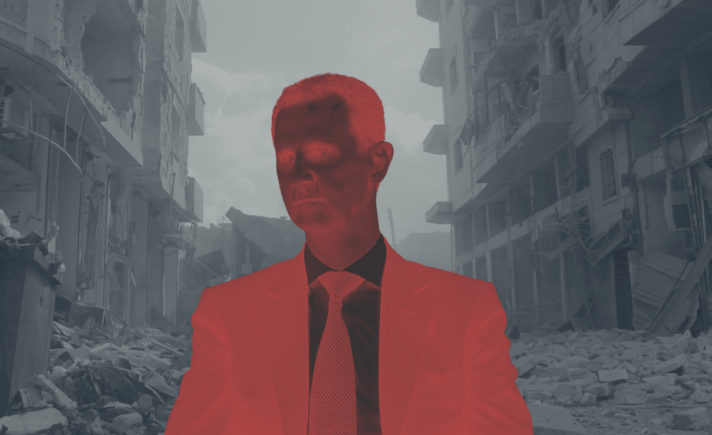While Assad regime forces and their Russian allies continued their war of displacement in the countrysides of Idlib and Aleppo last week, reports circulated Tuesday of a large Turkish military convoy’s entry into Idlib. This convoy was said to have begun installing a new so-called “observation post” to the south of Saraqeb, near the village of Tall Mardikh. The location marks the mid-point between Saraqeb and Ma’arrat al-Nu’man on the Damascus-Aleppo highway—the road thought to be the prize over which the latest battle is being fought. For those familiar with military developments in northern Syria in recent years, the news was ominous.
In August 2019, Turkish forces installed another of these observation posts on the same highway further to the south, in the Ma’r Hattat area between Ma’arrat al-Nu’man and Khan Shaykhun. The post’s installation coincided with regime’s advance on Khan Shaykhun and subsequent takeover thereof. Precisely the same scenario is unfolding today: Russian and Syrian fighter jets annihilate everything in sight, including hospitals and other vital facilities, rendering life impossible and forcing the displacement of civilians to the north and west. Regime forces then advance on the ground, under a hail of artillery and air strikes, and seize control over cities, towns, and villages after battles with opposition factions, passing Turkey’s observation posts unimpeded. Meanwhile, Russian and Turkish officials continue their talk of “de-escalation” in the area, as if this brutal war of displacement were occurring on a different planet, rather than in the very same area under discussion.
Silent observers
Since late 2017, Turkey has been installing these observation posts near the dividing line between pro- and anti-regime areas around Idlib and its countryside. The posts’ stated objective is to monitor the ostensible “de-escalation” and guarantee the prevention of violations. Each post contains military installations and fortifications, armored vehicles, and artillery carriages. Because Syrians are never privy to what goes on behind closed doors, residents of the areas in which the posts were erected initially had the impression they might provide protection against invasion by regime forces. For this reason, the arrival of Turkish forces was welcomed at the time.
In reality, this was not how events unfolded. The regime and Russia continued their destructive military campaigns as normal, seizing large swathes of territory to the south and east of the “de-escalation zone” after forcibly displacing the local populations. Not one of the Turkish observation posts reacted in any way to these offensives, aside from responding on rare occasions to sources of fire that targeted them directly. Any remaining hopes pinned on the observation posts evaporated when regime forces encircled the post in the town of Morek in northern Hama Province, which the regime then captured. To this day, the observation post in Morek remains in place, in an area controlled in its entirety by the regime, without anyone being able to say what the purpose of its continued existence there might be.
The same thing then happened again with the observation post in Sarman, east of Ma’arrat al-Nu’man, an area now completely taken over by the regime after a recent advance. And it looks set to recur with the post in Ma’r Hattat, which at the time of writing has been surrounded by the regime on three sides.
In the summer of 2019, when Turkish forces hastily erected the observation post in Ma’r Hattat, many Syrians presumed it would obstruct regime forces from advancing to Ma’arrat al-Nu’man after taking control of northern Hama Province and Khan Shaykhun. With the fall of Ma’arrat al-Nu’man to the regime on Tuesday, this illusion has been dispelled, just as it had been in Morek and Sarman.
Why, then, are Turkish forces now in the process of installing a new observation post south of Saraqeb? Once again, no one can say, but it is certainly not in order to prevent the regime from reaching Saraqeb, nor to “observe” any truce, ceasefire, or de-escalation in the area.
It’s also clear that the fate of the entire northwest of Syria is now hostage to Russian-Turkish agreements about which no verifiable public information exists. Certain reports in circulation suggest Turkey has agreed with Russia to assume responsibility for opening the international highways passing through Idlib to commercial traffic, under joint Turkish-Russian control. The claim is not particularly convincing, as neither party would wage campaigns costing millions of dollars for the sake of roads that can readily be substituted with others. It also seems unlikely that the aim of these recurrent battles is to dismantle the jihadist Hay’at Tahrir al-Sham group—formerly al-Qaeda’s official Syrian branch, known as Jabhat al-Nusra—after the latter supposedly abandoned its larger ideological ambitions, and no longer sought to do more than subjugate and terrorize local communities; the selfsame communities that the regime and Russia are busy destroying and displacing on the pretext of “eliminating terrorism.”
Whatever the precise content of the implicit Russian-Turkish understandings, we may be sure the bloody campaign underway is aimed at the communities that rebelled against the Assad regime in northern Syria. It’s telling that the convoys of displaced civilians fleeing the hellscape of Assad rule only ever move further away from it, toward areas remaining outside its control, as though it were a deadly plague spreading, pushing people to wander the plains and hills in desperate search of deliverance.

The above photo, posted on Facebook by Layth al-Abdallah, a civil defense volunteer in Saraqeb, shows displaced families near Saraqeb who have abandoned their cars, and wander through open fields seeking refuge from the fire targeting their convoys. The picture was taken not far from the new observation post that Turkey has reportedly begun installing south of Saraqeb.
On Tuesday, regime forces entered the city of Ma’arrat al-Nu’man after thousands of airstrikes and artillery launches. They arrived after emptying the city of its population, and after outgunned local fighters managed to put up lengthy resistance despite their opponents’ monopoly over the skies. Under the watchful eye of the Turkish observation post, Russia snatched Ma’arrat al-Nu’man from its people, destroyed vast sections of it, and displaced its population on the pretext of combating terrorism; this being the same city renowned for confronting the jihadists of Hay’at Tahrir al-Sham and their bloody, despotic violence.
States will continue to convene around the world, holding talks on “counter-terrorism” in Syria. Yet the people of Idlib and Ma’arrat al-Nu’man know all too well that they’re paying the price today for their courageous revolution against the Assad regime. The below photo, taken in Ma’arrat al-Nu’man in the spring of 2018, suffices to answer all the questions one might pose today, or in the future, regarding the real objectives of Russia’s, Iran’s, and Assad’s wars in Syria.

[Editor’s note: This article was originally published in Arabic on 29 January, 2020.]







